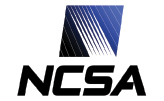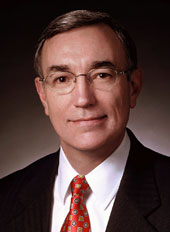AMES, Iowa -- Iowa State University researchers will be part of a research consortium helping to develop the world's most powerful supercomputer.
That machine will deliver sustained performance of a quadrillion calculations per second. That kind of speed and power is called a "petaflop" in computing circles.
The National Science Foundation is supporting the supercomputer project with a $208 million grant. The project is led by the University of Illinois at Urbana-Champaign and its National Center for Supercomputing Applications. Thom Dunning, the director of the NCSA, is directing the project.
The IBM-built machine will be called "Blue Waters" and will be based at Illinois. It is expected to go online in 2011.
Illinois will work with the Great Lakes Consortium for Petascale Computation -- a collaboration of industry and academic partners, including Iowa State -- to take on the challenges of petascale computing.
"Iowa State University is pleased to be part of the project to develop the world's most powerful supercomputer," said Iowa State University President Gregory Geoffroy. "This is truly an indication of the strengths and expertise Iowa State has developed in high performance computing applications, virtual reality and human computer interaction. This is another example of Iowa State advancing its vision to build exciting collaborations that put science and technology to work."
Srinivas Aluru, a Stanley Chair in Interdisciplinary Engineering at Iowa State and a professor of electrical and computer engineering, will direct Iowa State's work with the supercomputing consortium. Aluru led Iowa State's successful effort to win a National Science Foundation grant and bring "CyBlue" -- an IBM Blue Gene/L supercomputer capable of trillions of calculations per second -- to campus in 2006. He recently led another successful effort to win a National Science Foundation grant for a new supercomputer nearly five times more powerful than CyBlue. He's also won a science foundation grant to research how studies of molecular dynamics can be scaled to petaflop computers.
Aluru and the members of his research group have used supercomputing power to help with the recently concluded effort to sequence the corn genome. To do that, they developed software that uses thousands of processors to build genome assemblies in days instead of months.
And now Aluru is ready to make the leap to even more powerful computing.
"I am looking forward to solving large-scale problems in comparative genomics, systems biology, plant sciences and biorenewables research with the aid of petaflop computing," he said.
Mark Gordon, Iowa State's Frances M. Craig Distinguished Professor of Chemistry and the director of the Applied Mathematics Program for the U.S. Department of Energy's Ames Laboratory, said the jump in computing power will also advance several Iowa State projects in computational chemistry.
Gordon has led development of a software application that allows chemists around the world to compute a variety of molecular properties. Theresa Windus, an Iowa State professor of chemistry, has worked to develop another leading software tool in computational chemistry. And an Iowa State research team of Gordon; Windus; Monica Lamm, an assistant professor of chemical and biological engineering; and Masha Sosonkina, an adjunct associate professor of computer science and an Ames Laboratory scientist, recently won a $1.6 million, four-year grant from the National Science Foundation to develop petascale computing applications for computational chemistry.
James Oliver, the director of Iowa State's CyberInnovation Institute, said the jump to petascale computing power calls for tools such as C6, Iowa State's six-sided virtual reality room that displays computer-generated images at the world's highest resolution. He said C6 would be an ideal place to build interfaces that can display and work with all the data produced by the supercomputer.
Oliver said Iowa State's place in the supercomputer project allows the university to join what's been called the second revolution in information technology. Arden Bement, the director of the National Science Foundation, has said that revolution will be driven by developing a comprehensive cyberinfrastructure for the creation and application of knowledge.
"This puts us in the thick of that second revolution in science and engineering research," Oliver said.

